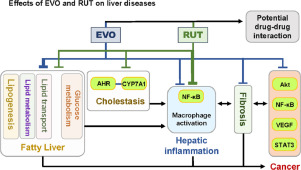当前位置:
X-MOL 学术
›
Phytomedicine
›
论文详情
Our official English website, www.x-mol.net, welcomes your
feedback! (Note: you will need to create a separate account there.)
Evodiamine and rutaecarpine from Tetradium ruticarpum in the treatment of liver diseases.
Phytomedicine ( IF 6.7 ) Pub Date : 2020-02-04 , DOI: 10.1016/j.phymed.2020.153180 Xiaojiaoyang Li 1 , Junde Ge 2 , Qi Zheng 3 , Jiaxiang Zhang 2 , Rong Sun 4 , Runping Liu 3
Phytomedicine ( IF 6.7 ) Pub Date : 2020-02-04 , DOI: 10.1016/j.phymed.2020.153180 Xiaojiaoyang Li 1 , Junde Ge 2 , Qi Zheng 3 , Jiaxiang Zhang 2 , Rong Sun 4 , Runping Liu 3
Affiliation

|
BACKGROUND
Liver is the pivotal organ responsible for plasma protein production, biliary secretion, xenobiotic elimination, glucose and lipid homeostasis. Dysregulation of these functions usually leads to liver diseases and further related complications. The incidence of liver diseases is increasing worldwide, with high morbidity and mortality when at advanced stages, and has become significant public health concern and substential economic burden. Thus, novel therapeutic strategies for managing liver diseases progression are urgently required. T. ruticarpum is one of the most famous and frequently used herbal medicine and has been prescribed in traditional Chinese medicine (TCM) formulas for the treatment of various ailments, including liver diseases. A considerable amount of bioactive ingredients have been isolated and identified from the roots of T. ruticarpum, including alkaloids, saponins, phenols, volatile oils and other compounds. Among these compounds, evodiamine (EVO) and rutaecarpine (RUT) are believed to be the most bioactive compounds.
PURPOSE
To summarize recent findings regarding to the metabolism, pharmacological/toxicological effects of EVO and RUT and to highlight the potential therapeutic effects of them against liver diseases.
METHODS
Online academic databases (including PubMed, Google Scholar, Web of Science and CNKI) were searched using search terms of "T. ruticarpum", "Wu Zhu Yu", "evodiamine", "rutaecarpine", "liver" and combinations to include published studies of EVO and RUT primarily from 2004-2019. Several critical previous studies beyond this period were also included.
RESULTS
Evodiamine (EVO) and rutaecarpine (RUT) are believed to be the most bioactive alkaloids in T. ruticarpum, having anti-inflammation, anti-fibrosis, anti-lipotoxicity, anti-cancer activities, and thus having potential to improve liver disorders. In the current review, we comprehensively summarized recent progresses in the studies of EVO- and RUT-mediated promising hepatoprotective effects and also provide novel insights regarding the potential use of EVO and RUT as therapeutic options for the treatment of liver diseases.
CONCLUSION
With further in-depth pharmacology and pharmacokinetic studies, we believe that natural products in T. ruticarpum and their derivatives will become promising medicines with improved clinical efficacy for the treatment of liver diseases in the immediate future.
中文翻译:

芸苔四叶草中的Evodiamine和rutaecarpine用于治疗肝脏疾病。
背景技术肝脏是负责血浆蛋白产生,胆汁分泌,异种生物消除,葡萄糖和脂质稳态的关键器官。这些功能的失调通常会导致肝脏疾病和其他相关并发症。在世界范围内,肝病的发病率正在增加,处于晚期时其发病率和死亡率很高,并且已成为重大的公共卫生问题和巨大的经济负担。因此,迫切需要用于治疗肝脏疾病进展的新颖治疗策略。芸苔T. ruticarpum是最著名和最常用的草药之一,并已在传统中草药(TCM)配方中处方用于治疗各种疾病,包括肝脏疾病。从芸苔的根中分离并鉴定出大量生物活性成分,包括生物碱,皂角苷,酚,挥发油和其他化合物。在这些化合物中,evodiamine(EVO)和rutaecarpine(RUT)被认为是最具生物活性的化合物。目的总结关于EVO和RUT的代谢,药理/毒理作用的最新发现,并强调它们对肝脏疾病的潜在治疗作用。方法使用“ T. ruticarpum”,“ Wu Zhu Yu”,“ evodiamine”,“ rutaecarpine”,“ liver”及其组合来搜索在线学术数据库(包括PubMed,Google Scholar,Web of Science和CNKI)。主要在2004-2019年间发表了EVO和RUT的研究。还包括此期间以外的一些重要的先前研究。结果Evodiamine(EVO)和rutaecarpine(RUT)被认为是芸苔中生物活性最高的生物碱,具有抗炎,抗纤维化,抗脂毒性,抗癌活性,因此具有改善肝脏疾病的潜力。在当前的审查中,我们全面总结了EVO和RUT介导的有希望的保肝作用研究的最新进展,并就EVO和RUT作为肝病治疗选择的潜在用途提供了新的见解。结论通过进一步深入的药理学和药代动力学研究,我们认为天然产物存在于T。
更新日期:2020-02-06
中文翻译:

芸苔四叶草中的Evodiamine和rutaecarpine用于治疗肝脏疾病。
背景技术肝脏是负责血浆蛋白产生,胆汁分泌,异种生物消除,葡萄糖和脂质稳态的关键器官。这些功能的失调通常会导致肝脏疾病和其他相关并发症。在世界范围内,肝病的发病率正在增加,处于晚期时其发病率和死亡率很高,并且已成为重大的公共卫生问题和巨大的经济负担。因此,迫切需要用于治疗肝脏疾病进展的新颖治疗策略。芸苔T. ruticarpum是最著名和最常用的草药之一,并已在传统中草药(TCM)配方中处方用于治疗各种疾病,包括肝脏疾病。从芸苔的根中分离并鉴定出大量生物活性成分,包括生物碱,皂角苷,酚,挥发油和其他化合物。在这些化合物中,evodiamine(EVO)和rutaecarpine(RUT)被认为是最具生物活性的化合物。目的总结关于EVO和RUT的代谢,药理/毒理作用的最新发现,并强调它们对肝脏疾病的潜在治疗作用。方法使用“ T. ruticarpum”,“ Wu Zhu Yu”,“ evodiamine”,“ rutaecarpine”,“ liver”及其组合来搜索在线学术数据库(包括PubMed,Google Scholar,Web of Science和CNKI)。主要在2004-2019年间发表了EVO和RUT的研究。还包括此期间以外的一些重要的先前研究。结果Evodiamine(EVO)和rutaecarpine(RUT)被认为是芸苔中生物活性最高的生物碱,具有抗炎,抗纤维化,抗脂毒性,抗癌活性,因此具有改善肝脏疾病的潜力。在当前的审查中,我们全面总结了EVO和RUT介导的有希望的保肝作用研究的最新进展,并就EVO和RUT作为肝病治疗选择的潜在用途提供了新的见解。结论通过进一步深入的药理学和药代动力学研究,我们认为天然产物存在于T。











































 京公网安备 11010802027423号
京公网安备 11010802027423号